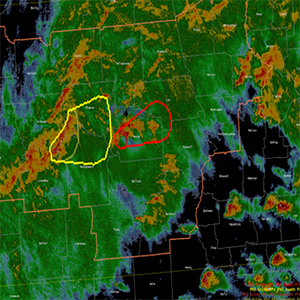Forecasters test Threats In Motion this spring

NOAA NWS forecasters are testing an experimental weather alert system called Threats In Motion (TIM). Threats in Motion lets forecasters create moving warning polygons for hazardous weather to alert the public in its path. The legacy warning system poses a challenge for forecasters when the hazardous weather appears to be continuing beyond the issued warning. Current procedures and software keep the forecaster from adjusting or moving the current warning as the storm evolves. This results in inconsistent lead times, which can cause confusion due to overlapping warnings.
Since 2019, GSL has been working on “Taller TIM,” a system that lets forecasters issue and update warnings as often as needed. The software in the background nudges the warnings at a frequency as high as one-minute intervals between forecaster updates.
An intermediate step between the current warning workflow and Taller TIM is known as “Tiny” TIM. Tiny TIM modifies the current warning software so the forecaster can nudge the existing warning forward along the storm's trajectory. This results in less workload for the forecaster, greater comprehension of warning updates, and improved lead times for communities downstream of the hazard. Since Tiny TIM is similar to the current warning workflow, forecasters can adapt to the concepts easily. It is hoped that Tiny TIM will pave the way for the operational implementation of Taller TIM.
In addition to nudging existing warnings along a storm’s path, forecasters can also use new tools to identify the worst parts of a thunderstorm and create the resulting warning area. Several of these new tools will be incorporated into the operational version of Hazard Services, also developed by GSL. The feedback from forecasters using Tiny TIM continues to be very positive, and forecasters are eager to adopt the new software.
The test was a collaboration of forecasters and researchers from GSL, National Severe Storms Laboratory (NSSL), the NWS’s Meteorological Development Lab (MDL), the Cooperative Institute for Research in the Atmosphere (CIRA) and the Cooperative Institute for Severe and High-Impact Weather Research and Operations (CIWRO).
